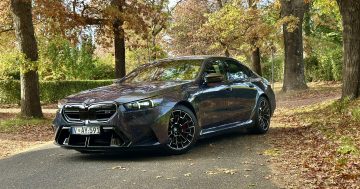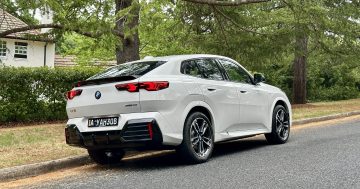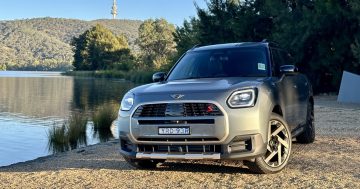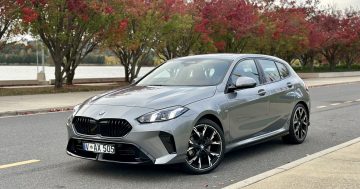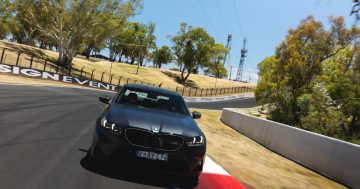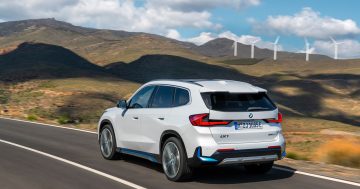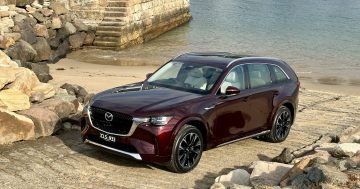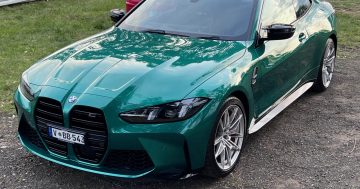By Karl Peskett.
 Bigger is better, or so they say. And while that’s true for spaciousness and practicality, it doesn’t hold true for pricetags.
Bigger is better, or so they say. And while that’s true for spaciousness and practicality, it doesn’t hold true for pricetags.
Take the new BMW X3, for example. It’s bigger in every dimension, including the price. And while the list price seems reasonable for the amount of improvements the X3 has made over the previous model, add in a few options and the price quickly escalates.
Consider our test vehicle. As an X3 xDrive20d, it’s the entry level diesel model, and it comes with a sticker price of $68,900. It’s a lot of car for the money, especially with a blue and white propeller up front. But add in a few niceties and let’s watch the dollars add up.
Add in an electric panorama glass sunroof ($3,000), Driving Assistant Plus ($2,800), metallic paintwork ($1,950), Fineline Cove wood trim with Pearl Chrome highlights ($550), Leather ‘Vernasca’ Mocha seats with decorative stitching ($2,500) and you’re only part of the way there.
 Then there’s the Innovations Package which includes Comfort access system, Parking Assistant Plus, Adaptive LED headlights, and Multifunctional instrument display ($3,250), LED fog lights ($380), Dynamic Damper Control ($1,900), luggage-compartment separating net ($400) and finally 20-inch light alloy wheels in two colours ($2,500) and you come to a grand total of $88,130. Yes, nearly $20K more than the original price before on-road costs. Ouch.
Then there’s the Innovations Package which includes Comfort access system, Parking Assistant Plus, Adaptive LED headlights, and Multifunctional instrument display ($3,250), LED fog lights ($380), Dynamic Damper Control ($1,900), luggage-compartment separating net ($400) and finally 20-inch light alloy wheels in two colours ($2,500) and you come to a grand total of $88,130. Yes, nearly $20K more than the original price before on-road costs. Ouch.
Clearly, there are plenty of options you could simply leave off. And considering the X3 is quite well stocked as standard, some of these options are definitely luxuries and not necessities. But let’s look at why the new X3 is worth checking out.
Clearly, diesels are on their last legs so this one could be one of the last we’ll see for a while. BMW makes fabulous engines and always has, so what makes this one so remarkable? Its refinement.
Oil-burners are a bit rough when starting and running, but this 2.0-litre turbocharged four-cylinder is the gold standard when it comes to smoothness. Producing 140kW and 400Nm, it’s matched to ZF’s lovely eight-speed automatic, helping smoothness even more so.

Clearly, it’s not the most powerful, nor the torquiest engine around, which is why it takes 8.0-seconds to get to 100kmh from rest. But with a fuel consumption figure of just 5.7L/100km, you won’t have to visit the bowser very often at all. And in this climate of climbing fuel prices, we need all the help we can get.
Power runs to all four wheels (hence the “x” in xDrive) but with a rear-biased setup that allows the X3 to be quite playful when you want it to be. But stick it on a very slippery surface such as gravel or even sand and the all wheel drive system works a treat in keeping the X3 moving along quite well.
As you could see from the options above, our tester had the optional adaptive suspension, which does a great job in firming up for when you want to tackle some twisty tarmac. But of course, with 20-inch wheels, the comfort setting only softens up the dampers, with the thin-walled tyres still relaying firmness through the car. That said, with some smaller wheels on it, the X3’s ride would be very good indeed.
Dynamically, the X3 is extremely accomplished and regardless of which damper setting you choose, it’s still quite comfortable. But unfortunately, BMW has ruined the steering.

The previous model, with its hydraulic steering pump, had wonderful weighting and feel, especially as you wound on steering lock. The new model’s electric steering is now numb and the weighting is too light, creating a very disconnected sensation. It’s a shame because for years BMW was the company that had the best steering feel in the business.
We know why they’ve done it – electric steering is far better for fuel economy as it puts less strain on the engine than a hydraulic pump – but when this aspect is a core brand value, it means that there’s less incentive to opt for a BMW instead of, say, an Audi Q5 or Mercedes-Benz GLC.
Where it does claw back some ground is inside. The interior space is huge and like the Volvo XC60, the X3’s back seat has plenty of legroom and headroom. This generation of X3 is actually larger and roomier than the first generation X5. The build quality is excellent, too, and the new iDrive system works as intuitively as you’d expect, though some of the menu items have been shifted around if you were used to the previous iDrive setup.

The boot is accessed by a powered tailgate, and there’s 40:20:40 rear seat split-folding, which can expand boot space from a 550 litres to a massive 1600-plus litre space.
Bluetooth, a head-up display, digital radio with an excellent sound system, wireless phone charging, emergency call button, Connected Drive (which has an app so you can find your car), parking assist and all the latest safety gear means the X3 is comprehensively stocked.
Which is why we think that the X3 is a good package when simply left as is. If you don’t care about steering feedback (and let’s face it, most SUV buyers don’t), then when void of optional extras, the X3 is a decent thing. It’s spacious, comfortable, well-built and looks great. In fact, given the X3’s size, you have to wonder who would need an X5.


